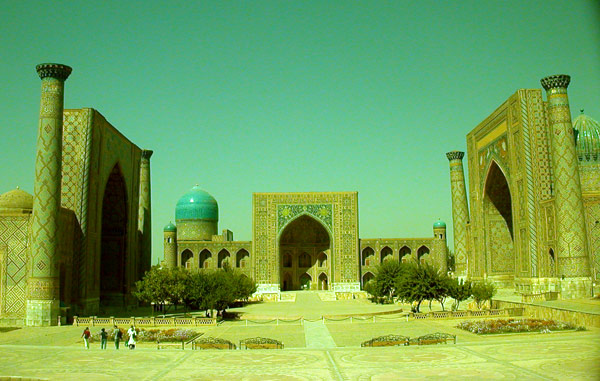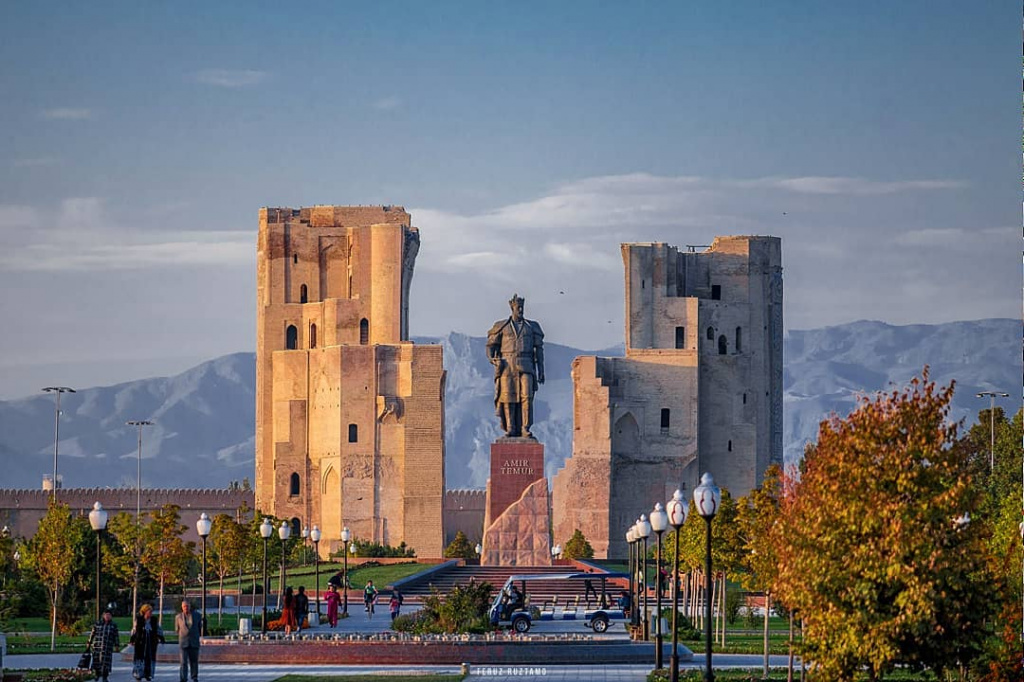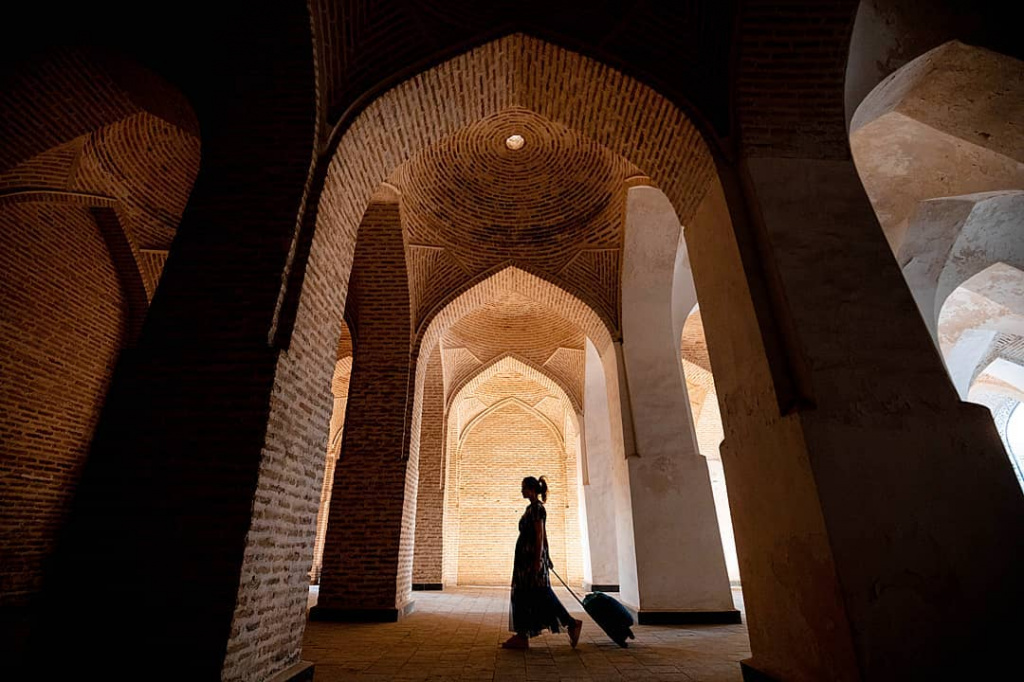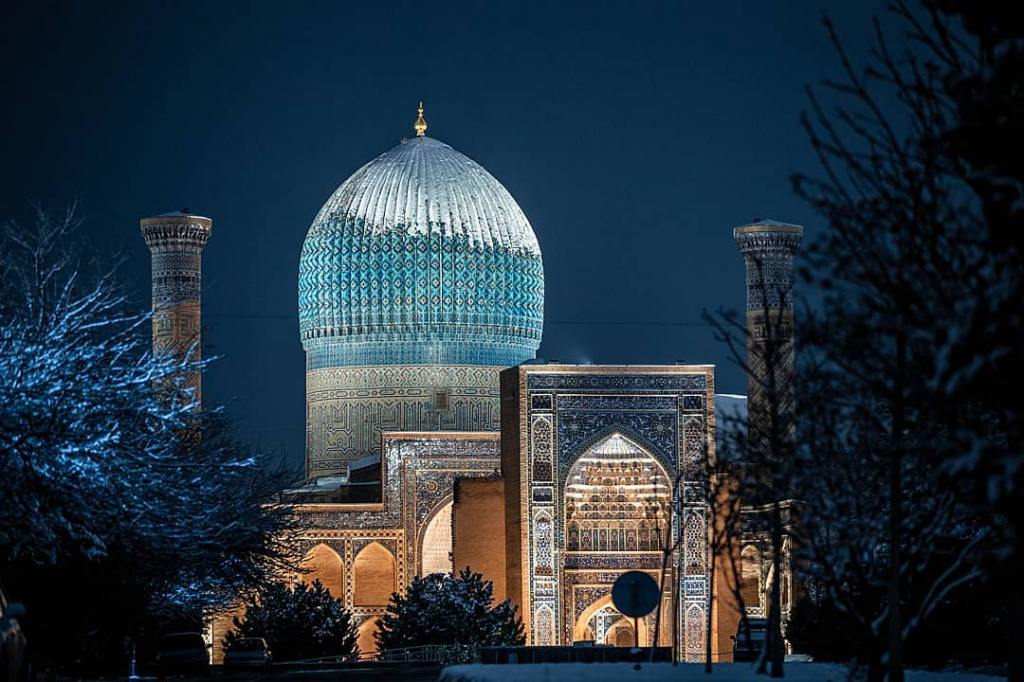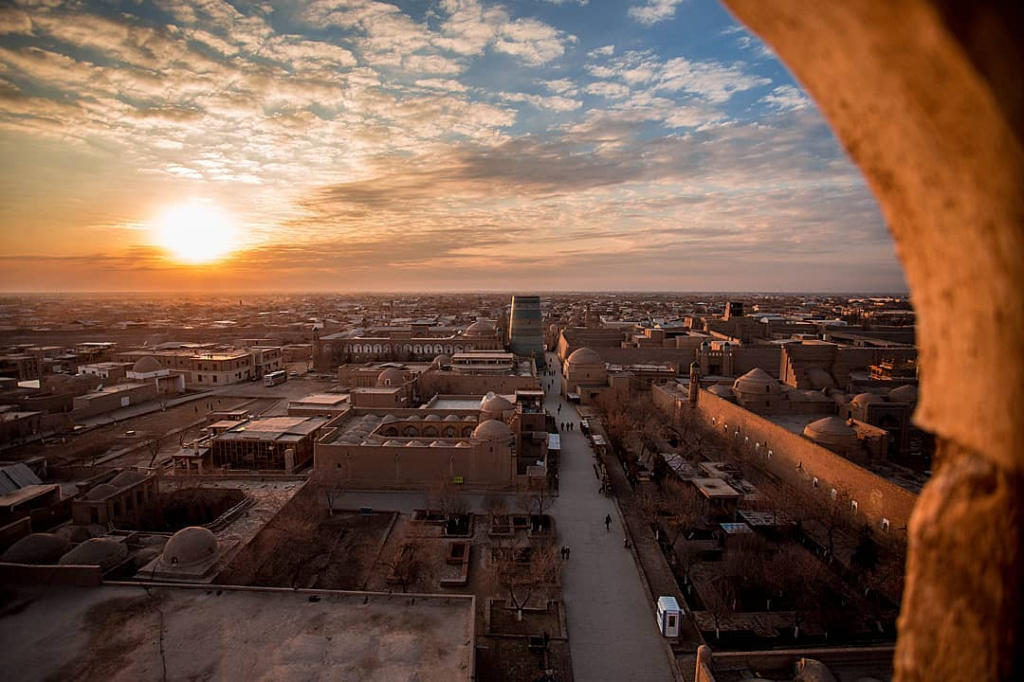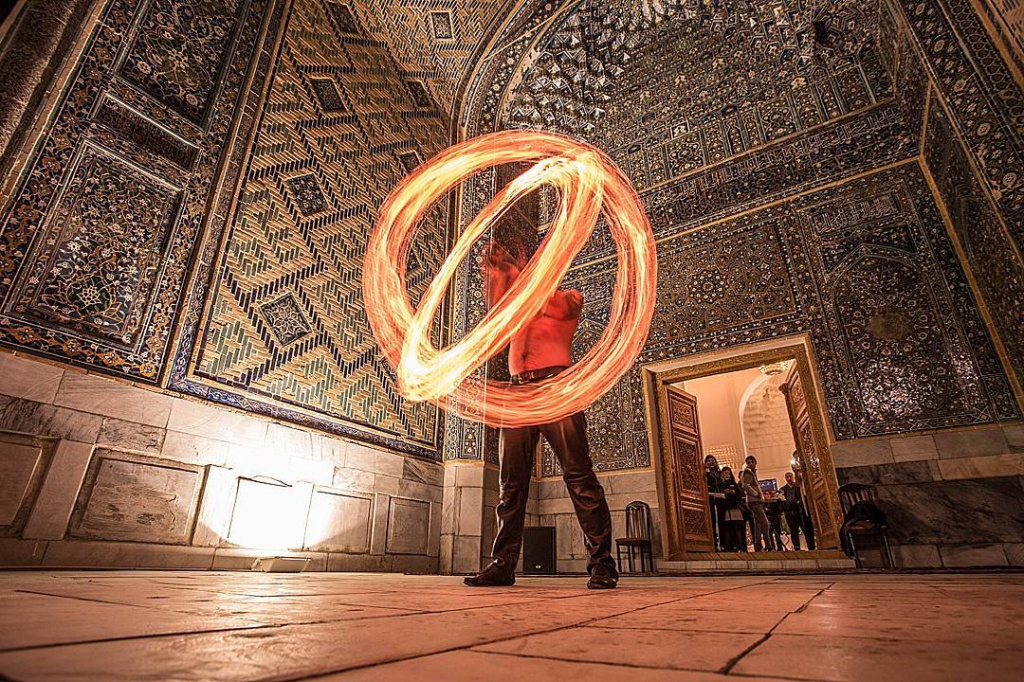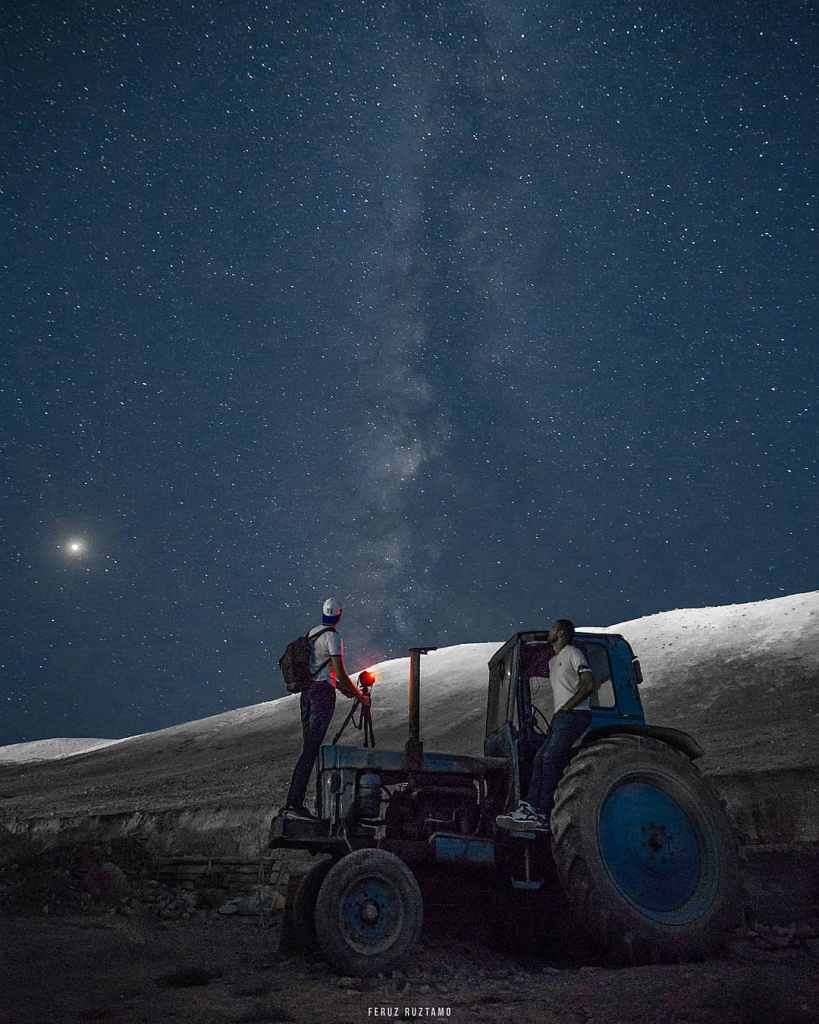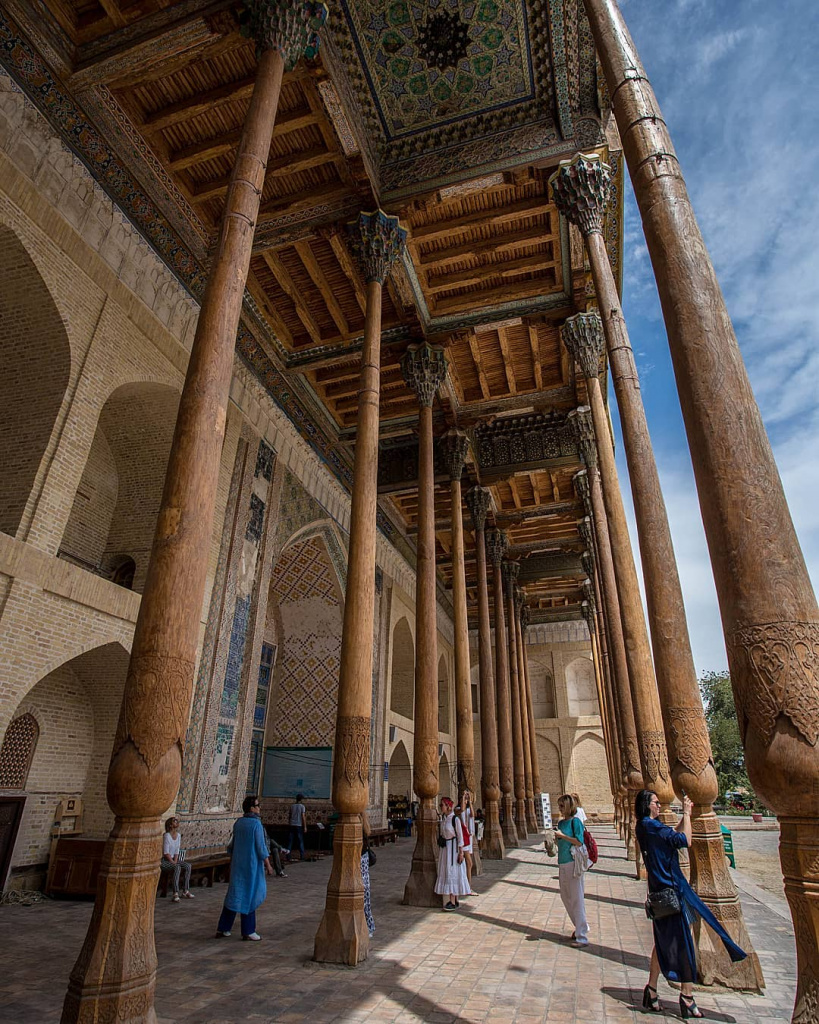
The mosque Bibi Khanym (Persian: مسجد بیبی خانم; Uzbek: Bibixonim Masjidi; Russian: Мечеть Бибиханым; German: Bibi Khanum Moshee; also: … Khanom / Hanum/ Chanym / Hanim, etc.) is one of the most important monuments of Samarkand. In the 15th century it was one of the largest and most magnificent mosques in the Islamic world. By the mid-20th century only a grandiose ruin of it was survived, but now major parts of the mosque have been restored.
Origin and Meaning
Bibi Khanym Mosque was built between 1399 and 1404 by order of the Central Asian ruler
Timur (Tamerlane). Previously Timur had expanded his power in several successful campaigns from Syria to India and had risen to become the most powerful ruler of the Islamic world. The construction of the new Friday Mosque (Great Mosque) in Timurs’s capital Samarkand is probable the claim to put the sign of his power in political and religious life of vast region of Asia.
Though Timur personally monitored and corrected the construction of the building, it was not quite completed until his death in 1405.
Soon after the building became a huge place of worship, it began to collapse and fall into ruin. The original impulse of its creator was perhaps too impertinent, as he attempted to accomplish what was at the time an almost unreal architectural idea. But perhaps there was a more deep reason of its collapse. It is commonly known that rulers often build temples in an attempt to please God. The Bibi-Khanym might have been intended as a huge thank-offering by the Emperor Timur after his successful Indian campaign. Or was it perhaps built in atonement for his many sins? The capture of Delhi was remarkable for its excessive cruelty. When Tamerlane over-ran India, he left a trail of carnage all the way to Delhi, where he reduced the city to rubble and massacred 100,000 inhabitants. The truth will always remain a mystery. At least it looks as if God rejected the bloody offering, whatever kind it was.
To the true story of origin of the mosque was later implicated a romantic legend in which Bibi Khanym, the favorite wife of Timur, is presented as a builder of.
Architecture
The mosque follows the basic type of the courtyard mosque. Its outer walls enclose a rectangular area which measures 167 by 109 m and runs along roughly from northeast to southwest – the
Qibla accordingly. However the size of the site vacant of covered galleries was only 78 by 64 meters.
One who enters the Mosque from the northeast through the vast, about 40 m high, parade portal gets in the courtyard. A monumental dome above square base, around 40 m high, rises on the opposite site of the courtyard. The dome is the largest cupola of the mosque. Nevertheless, the dome cannot be seen from the courtyard, for whole building is covered up from inside by the grandiose pischtak, which framed a monumental, deeply embedded Iwan. The Iwan does not allow getting inside the underlying construction supporting the dome; this can only be done from the sides. Two other domes associated with the Iwans, more modest in their size, are facing at the center of the long sides of the courtyard. Thereby, the Bibi Khonym Mosque implements the classic Persian-Islamic architectural type of the “Four-Iwan scheme”.
Into the perimeter of the courtyard in former time there were open galleries of 7.2 m high. Their cover was formed from the juxtaposition of many small, flat brick vaults and domes supported by a forest of more than 400 marble columns and buttresses. Today, only hints of the galleries can be seen.
Four minarets at their outer corners of the site are already restored. Four other, more majestic minarets that flanked the Portal arch of the entrance and the Pischtak of the main domed building are not completed yet.
In the middle of the courtyard is located the stone pedestal – the huge Quran stand from ornate marble blocks, this remarkable sight is also from the time of Timur..
The huge BIbi Khonym Mosque with its three domed rooms, the covered galleries and the open courtyard was intended to gather the entire male population of Samarkand city for the joint Friday prayers.
Artistic design
In the construction of three domes of Bibi-Khanym mosque, sophisticated in Timur’s time, one important innovation was applied, it is Two-fold construction, where the internal dome hall neither by the form nor by height corresponds to the dome’s shape from outside. Reason for this is that between inner ceiling and outer cupola is the hollow space. This dome construction allowed main hall of the mosque to be committed to the proportions and the aesthetics of the 30 m high interior above the mihrab, meanwhile 40 m high outer dome of the main building could be designed towards maximal impression and visibility. This scheme was applied also to the lateral dome structures that allowed making modest buildings the figuration tower-like structures with elegant melon-shaped and longitudinally ribbed outer domes. When construction was completed in 1404 it gripped minds of many poets. The Bibi-Khanym was compared to the beauty and brilliance of the Milky Way. Unfortunately the beauty of interior in Bibi-Khonym mosque is almost completely lost, however one can get an idea of how it might
look like by visiting the Gur-Emir mausoleum, where was used same technique.
In the decoration of the Bibi-Khinym Mosque all the traditions of Central Asia and Persia and even architectural ideas from India were used. One can see there elements of mural incrustation, decorative marble panels, stucco decorations and mural painting. Especially glazed ceramics can be found here in all of its forms such as the turquoise large main dome, the geometric mosaic of large wall surfaces, the multicolored ceramic to the frames of the arches and the ribs of the side domes; the delicate mosaic of countless interwoven by arabesques, elegant Thuluth font frieze on the cobalt blue and ornate gold faience on the drum under the great dome.
The interior of the dome rooms still shows traces of colored Al-secco painting and decorative elements made of paper mache, decorated with gold leaf and also blue – the latter an invention of that time. Also the some elements of the encrusted marble pedestal have been preserved.
Fate and current state
When Timur had returned from his military campaign in 1404 the mosque was almost completed. However Timur was not happy with the progress of construction, therefore he had immediately made various changes, especially concerning the main cupola.
From the beginning of the construction, problems of statistical regularity of the structure revealed themselves. Various reconstructions and reinforcements were undertaken in order to save the mosque. However, after few years the first bricks had begun to fall out of the huge dome over the mihrab. It forced
Timur to retaliate often beyond the structural rules. His builders were certainly aware of that, however he didn’t want to accept their opinion and reality.
Late 16th century the Abdullah Khan II (Abdollah Khan Ozbeg) (1533/4-1598), who was the last Shaybanid Dynasty Khan of
Bukhara, from 1583 until his death, had cancelled all restoration works in Bibi Khonym Mosque. [8] After that, the mosque came down and became a ruins gnawing at the wind, weather and earthquakes. The inner arch of the portal construction was collapsed in 1897. During the centuries the ruins were plundered by the inhabitants of Samarkand in search of building material especially the brick of masonry galleries along with the marble columns.
In the 20th century the ruins of the Mosque Bibi Khanym still impressed those visiting the city with its huge dimensions and still recognizable precious refinements. A first basic investigation and securing the ruins was made in Soviet times. Late 20-th century the Uzbek government began with the restoration of three dome buildings and the Main portal. The decoration of domes and facades was extensively restored and supplemented. Work on the mosque restoration last up till now.
Name
It is unclear when the name Bibi Khanym Mosque arose. In the Middle Ages the Mosque only as great mosque or Friday mosque was mentioned.
Historically, Bibi Khanym (خانم بیبی, Persian: Madam Bibi) has not been used as the name of a wife of Timur. In Persian Bibi is also more of a general honorific name with the meaning of highly respected woman, particularly as respectful form of address for the paternal grandmother.
But Bibi Khanym Mosque has a nexus to Timur’s principal wife Sarai-Molk Khanym. While Timur was years in his military campaigns, his wife (was already an elderly lady) was most probably overseeing the work on the mosque, the most important new development of capital. What is certain is that under the
aegis of Sarai-Molk Khanym directly opposite the mosque Bibi Khanym one in the same time a madrasah had been built. [12] Only one dome structure of former madrasah has remained today, which has been mistakenly handed down by fame as the mausoleum of Bibi Khanym.
